 新闻详情
新闻详情
 新闻详情
新闻详情

万双网讯 为提升学生英语演讲与跨文化表达能力,深化人与动物和谐共处的理念,培养学生面向未来的责任感,2025年6月11日中午13:40,万科双语学校第49期E-talk活动以“古韵新声(Humans and culture)”为主题在学校剧场举行。
To enhance students’ English speaking and cross-cultural expression abilities, deepen the ideals of a harmonious coexistence between humans and animals, and cultivate a sense of responsibility for the future, the 49th E-Talk event at Vanke Bilingual School was held in the school theater on June 11, 2025, at 1:40 PM, with the theme “Ancient Charm, Modern Voice (Humans and Culture).”
活动由7E班的杨静怡(Katerina)和7G班的张蕴哲(Andy)担任主持人,Tim老师和Heaven老师担任评委。来自七、八年级的11名学生用英语分享了他们与传统文化之间的故事与思考,活动吸引了百余名师生到场聆听,并通过校园直播面向全校同步呈现。
The event was hosted by Yang Jingyi (Katerina) from Class 7E and Zhang Yunzhe (Andy) from Class 7G, with Tim and Heaven serving as judges. Eleven students from the seventh and eighth grades shared their stories and reflections on traditional culture in English. The event attracted over a hundred teachers and students to attend and was also broadcast live to all teachers and students.
7I肖俊博(Thomas):Gu Qin
Class 7I Xiao Junbo (Thomas): Gu Qin
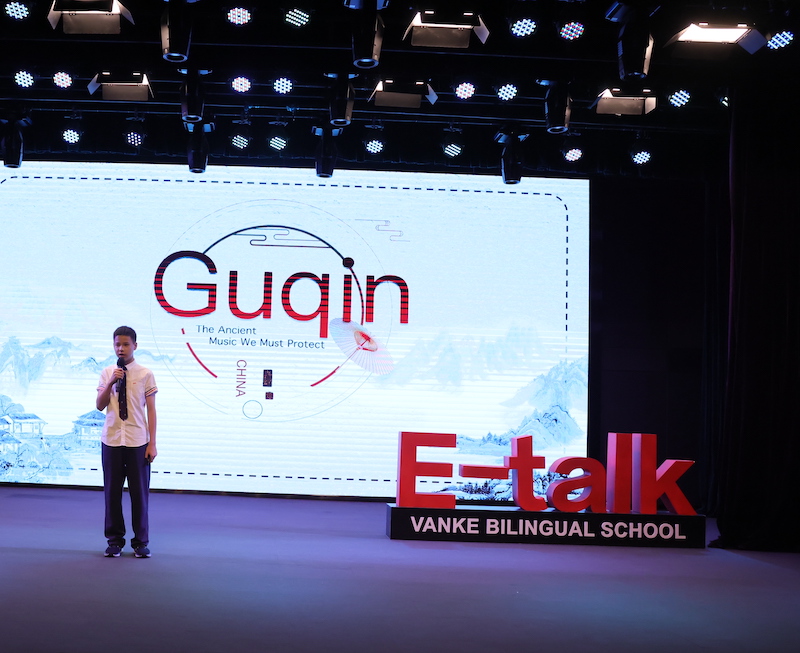
7I班的肖俊博在演讲中指出,古琴作为2003年被列入联合国教科文组织非物质文化遗产的“圣人之器”,既是孔子修身养性的工具,承载着儒家文化精神,也是“知音”典故的象征;1977年其曲目《流水》飞向太空,成为人类文化的“宇宙名片”。但如今面临熟练演奏者稀缺、认知偏见及古老记谱法难以传承等困境;为此,他提出通过抖音融合流行元素实现潮流化传播,以及走进博物馆观察木料、感受历史厚重感的保护倡议 。
In his speech, Xiao Junbo from Class 7I pointed out that the Gu Qin, recognized as a “sacred instrument” by UNESCO in 2003 as part of the intangible cultural heritage, is not only an instrument used by Confucius, embodying the spirit of Confucian culture, but also symbolized the tale of “zhiyin” (a close friend who understands you). In 1977, its piece “Flowing Water” was sent into space, becoming a “cosmic business card” of human culture. However, it currently faces challenges such as the scarcity of skilled performers, cognitive biases, and difficulties in passing down ancient notation methods. To address this, he proposed a protection initiative that includes using TikTok to integrate popular elements into trendy videos and visiting museums to observe wood materials and experience the richness of its history.
8E濮阳毅(Hubert)&王文昊(Timmy):Traditional Chinese Medicine
Class 8E Pu Yangyi (Hubert) & Wang Wenhao (Timmy): Traditional Chinese Medicine
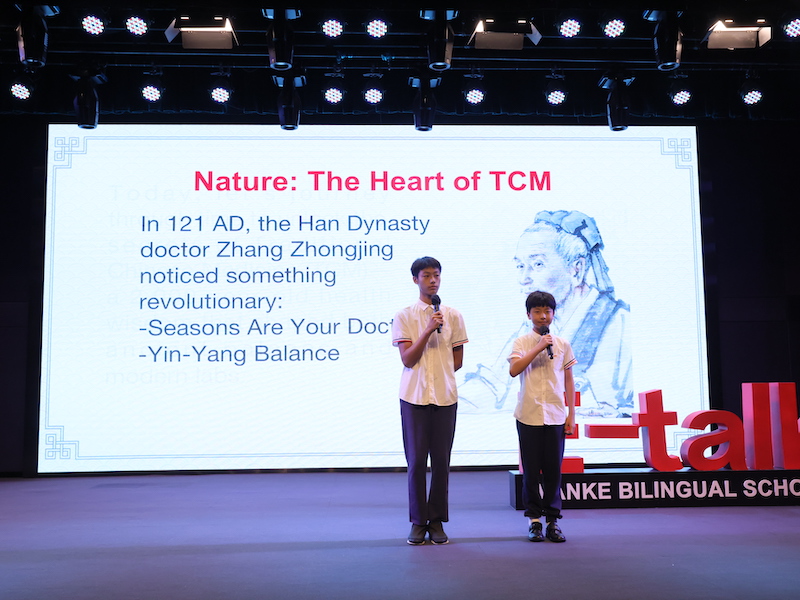
8E班的王文昊和濮阳毅在演讲中阐述了中医文化的核心理念——“顺应自然”和“阴阳平衡”。他们提到张仲景提出的四季养生法则及黑芝麻滋阴的现代科学验证。同时,他们列举了针灸、草药、眼保健操等实践案例,既追溯到青铜针治伤的古代应用,又关联到NASA的研究和宇航员带草药上天的现代探索。他们还以屠呦呦发现青蒿素为例,彰显了中医对现代医学的贡献。最后,他们给出饮用柠檬温水等日常养生建议。演讲通过古今案例结合、科学数据佐证,将中医智慧与现代生活紧密相连,兼具文化深度与实用价值。
In their speech, Wang Wenhao and Pu Yangyi from Class 8E elaborated on the core concepts of Traditional Chinese Medicine (TCM) culture— “Harmonizing with Nature” and “Yin-Yang Balance.” They mentioned Zhang Zhongjing’s principles of seasonal health maintenance and the modern scientific validation of black sesame for nourishing Yin. They also cited practical examples such as acupuncture, herbal medicine, and eye exercises, tracing back to ancient uses of bronze needles for healing, while connecting these to NASA’s research and usage of herbal medicine by astronauts in space. They highlighted the contributions of TCM to modern medicine by referencing Tu Youyou’s discovery of artemisinin. Finally, they provided daily health tips such as drinking warm lemon water. Their speech effectively intertwined ancient and modern examples with scientific data, connecting the wisdom of TCM with contemporary life, showcasing both its cultural depth and practical value.
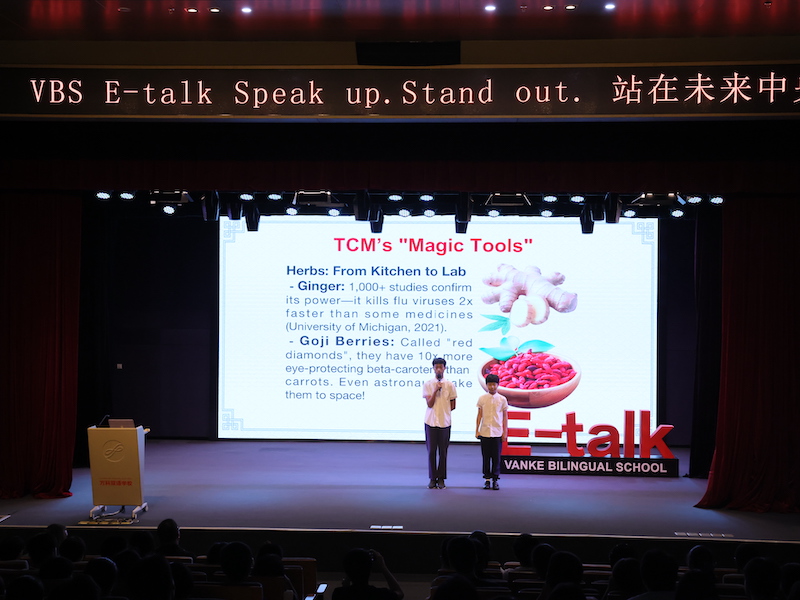
8D邓芃(Thomas)&8C廖子汉(Henry):The Cultural Symbol of China
Class 8D Deng Peng (Thomas) & Class 8C Liao Zihan (Henry): The Cultural Symbol of China
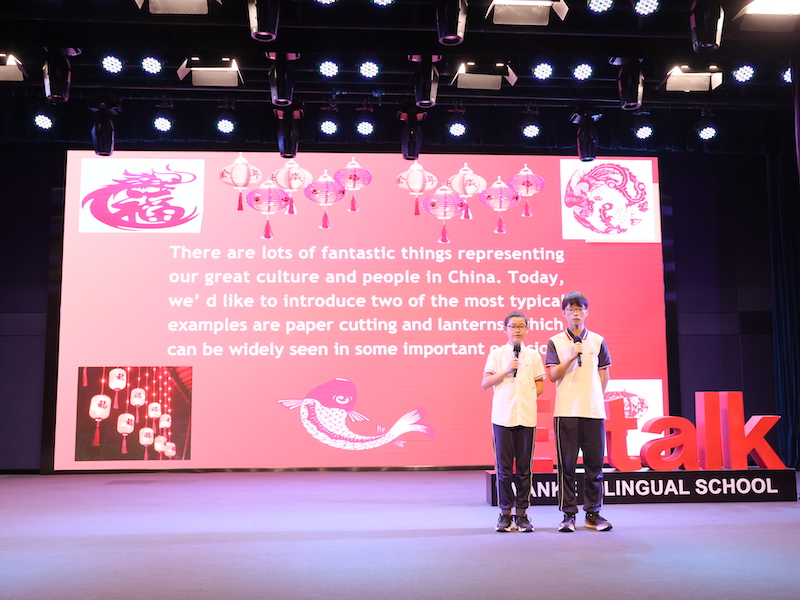
8C班的邓芃和8D班的廖子汉在演讲中聚焦中国文化符号——剪纸与灯笼。他们介绍,剪纸自汉代起源,唐宋盛行,历经1500多年,凭借剪刀、彩纸等简单工具,以红色为基调创作图案,在春节、婚礼等场景传递吉祥寓意。灯笼则始于西汉,从实用照明逐渐演变为唐代元宵节的象征。红灯笼寓意团圆兴旺,天灯承载美好愿景。作为活态文化遗产,红灯笼和天灯凝聚着人们对生活的热爱与期盼。他们呼吁年轻人积极传承这些艺术形式,让它们承载的希望与梦想永葆生机。
In their speech, Deng Peng from Class 8C and Liao Zihan from Class 8D focused on some cultural symbols of China—paper cutting and lanterns. They introduced the history of paper cutting, which originated in the Han Dynasty and became popular during the Tang and Song Dynasties. Over 1,500 years, it has been made from simple tools like scissors and colored paper to create patterns with a red theme, conveying auspicious meanings during occasions such as the Spring Festival and weddings. Lanterns, which began in the Western Han Dynasty, evolved from a practical lighting method to a symbol of the Lantern Festival in the Tang Dynasty. Red lanterns symbolize reunion and prosperity, while sky lanterns carry beautiful wishes. As a living cultural heritage, red lanterns and sky lanterns embody people’s love and hopes for life. They called on young people to actively practice these art forms, ensuring that the hopes and dreams they represent continue to thrive.
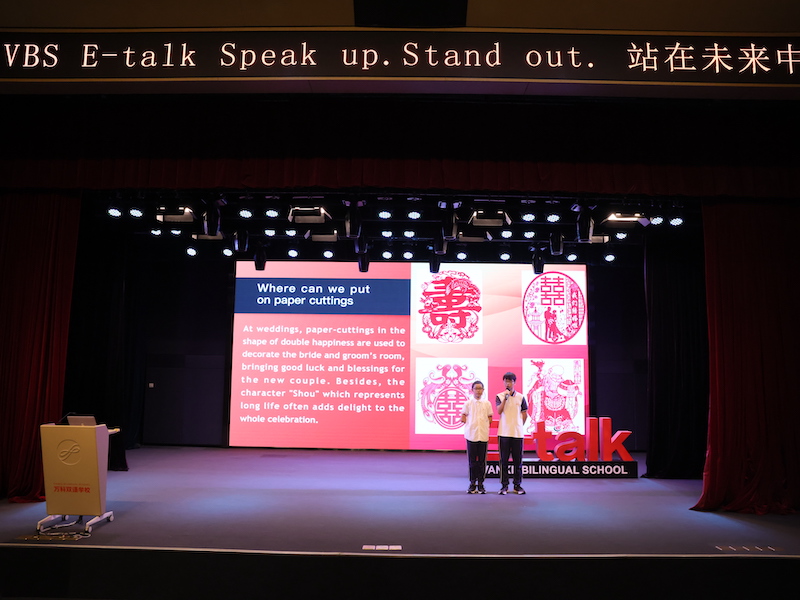
8C刘思淇(Alice)&姚罗衾(Ann):The Charm of Traditional Skills
Class 8C Liu Siqi (Alice) & Yao Luoqin (Ann): The Charm of Traditional Skills
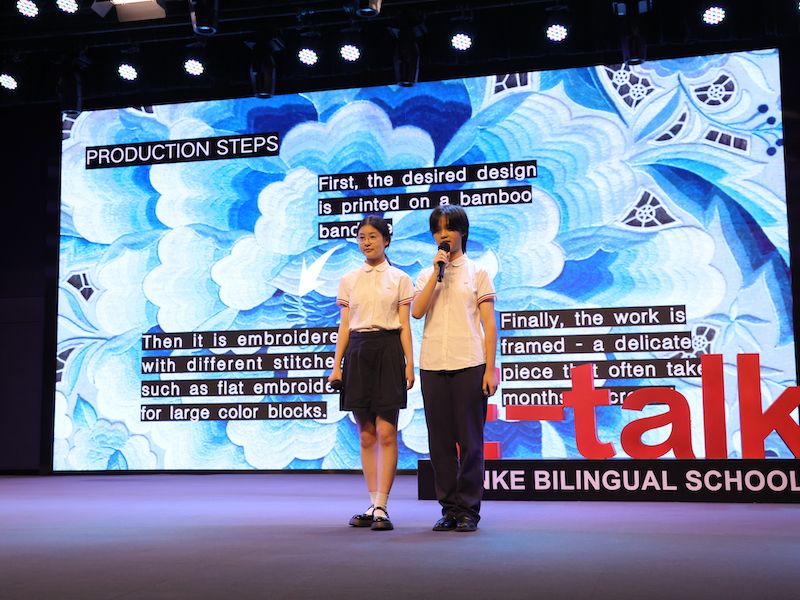
8C班的刘思淇和姚罗衾在演讲中深入展现了传统技艺糖画与刺绣之美。糖画源于明代祭祀,清代演变为街头艺术。艺人以勺作笔、糖液为墨,在光滑板上即兴勾勒龙、花等图案,几秒即成。她们还结合班级同学父亲在学校神话节设摊的实例,体现了糖画的受欢迎程度,并赞叹了古人的智慧。刺绣则自周代起源,从宫廷装饰发展成了中国美学巅峰代表。它经过印图、针法绣制、装裱等繁复流程,一件精品往往耗时数月。她们致敬姚建平、顾文霞等传承人,盛赞其用针线赋予丝绸生命力,凸显传统技艺传承的不易与珍贵。
In their speech, Liu Siqi and Yao Luoqin from Class 8C showcased the beauty of traditional crafts, specifically sugar painting and embroidery. Sugar painting originated from sacrificial rituals in the Ming Dynasty and evolved into a form of street art during the Qing Dynasty. Artists use a spoon as a pen and sugar syrup as ink to spontaneously sketch patterns such as dragons and flowers on a smooth surface, completing works in just a few seconds. They also referenced an example of a classmate’s father setting up a stall at the school’s Mythology Festival, highlighting the popularity of sugar painting and marveling at the wisdom of ancient artists. Embroidery, which began in the Zhou Dynasty, developed from court decorations to become a pinnacle of Chinese aesthetics. It involves complex processes such as pattern printing, stitching techniques, and framing, and a fine piece can take months to create. They paid tribute to practitioners like Yao Jianping and Gu Wenxia, praising their ability to breathe life into silk with their needles and thread, highlighting the challenges and value of preserving traditional crafts.
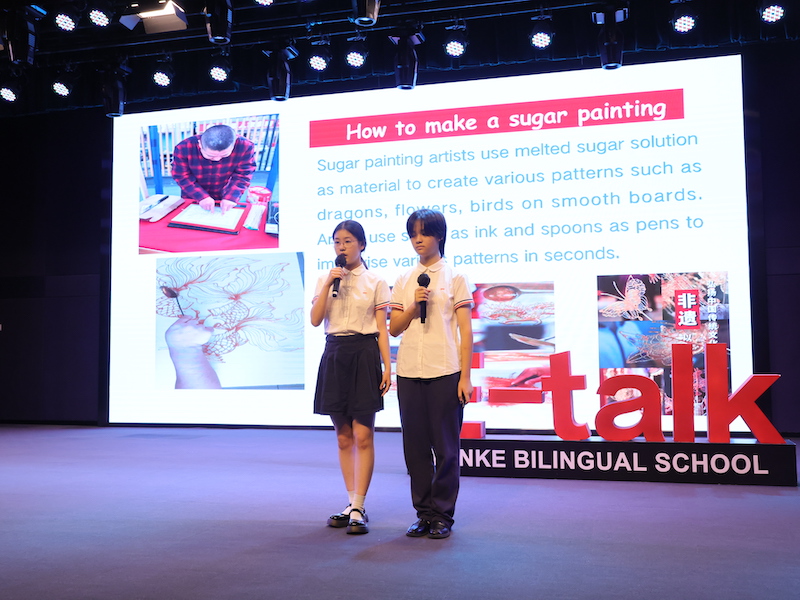
7C闫语晨(Emily)&何政东(Ray):The Dragon Boat Festival
Class 7C Yan Yuchen (Emily) & He Zhengdong (Ray): The Dragon Boat Festival
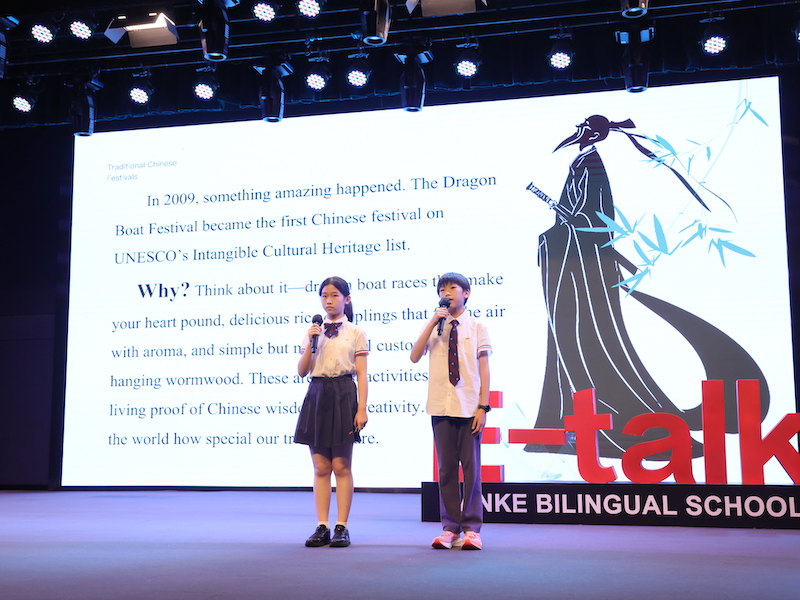
7C班的闫语晨与何政东以“端午节:传统节日的文化密码”为题展开演讲。他们先介绍了端午节在农历五月初五,又称“重五节”,是为纪念屈原而设立的节日,并于2009年成为首个列入联合国教科文组织非物质文化遗产的中国节日。接着,他们阐述了端午节习俗背后的深层内涵:挂艾草、饮雄黄酒是雨季天然的防虫保健方式,体现人与自然和谐相处的理念;赛龙舟需众人依鼓点协作,彰显团结精神;全家包粽子则承载着浓厚的家庭温情。最后,他们提出青年传承的建议,鼓励同学们在校参与文化项目、创办社团,与家人共度节日并通过社交媒体传播。他们强调,端午节作为文化核心,是连接古今的桥梁,呼吁大家共同守护传承这一节日的独特魅力。
Yan Yuchen and He Zhengdong from Class 7C delivered a speech titled “The Dragon Boat Festival: The Cultural Code of Traditional Festivals.” They began by introducing the Dragon Boat Festival, celebrated on the fifth day of the fifth lunar month, also known as “Double Fifth Festival,” which was established to commemorate Qu Yuan and was recognized as the first Chinese festival included in UNESCO’s Intangible Cultural Heritage list in 2009. Next, they elaborated on the deeper meanings behind the customs of the Dragon Boat Festival: hanging mugwort and drinking realgar wine are natural ways to deter insects during the rainy season, reflecting the idea of harmonious coexistence between humans and nature; dragon boat racing requires teamwork in sync with the drum beats, showcasing the spirit of unity; and making zongzi (sticky rice dumplings) as a family carries deep familial warmth. Finally, they proposed suggestions for youth activities, encouraging classmates to participate in cultural projects, establish clubs, celebrate the festival with their families, and share their experiences on social media. They emphasized that the Dragon Boat Festival, as a cultural core, serves as a bridge connecting the ancient and the modern, calling on everyone to jointly preserve the unique charm of this festival.
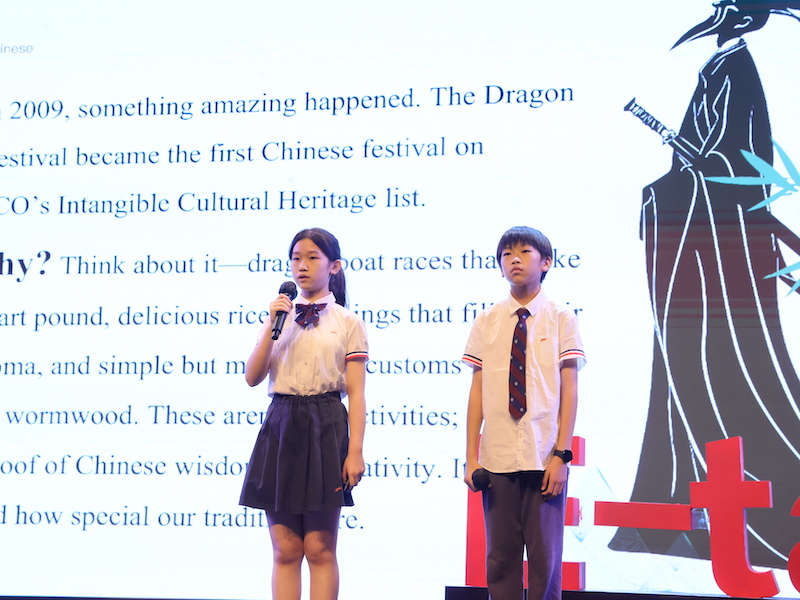
8F娄沛思(Pansy)&朱雨昕(Annie):Tie-Dye: The Magic of Colors
Class 8F Lou Peisi (Pansy) & Zhu Yuxin (Annie): Tie-Dye: The Magic of Colors
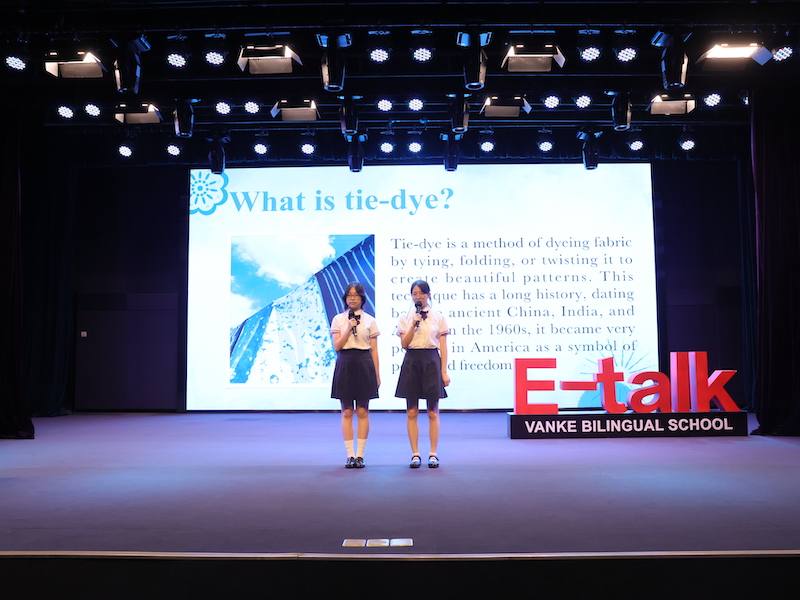
8F班的娄沛思和朱雨昕在演讲中介绍了扎染。那是一种通过捆绑折叠布料染色的古老工艺,起源于中、印、非洲古代。20世纪60年代,沾染在美国被认为是和平、自由象征。扎染没有规则限制,能够激发创意,使用的材料简单有趣,还可以用于改造旧衣物,兼具环保与时尚的特点。扎染的制作步骤包括准备布料、造型、染色、静置和冲洗。扎染的应用非常广泛,许多知名品牌都采用了这种工艺。作为一种手工艺,它传承着古老的民族文化。在演讲中,娄沛思和朱雨昕以清晰的脉络结合了扎染的历史渊源、操作实践和现代价值,并通过“失误变设计”等细节增强了演讲的吸引力。
In their speech, Lou Peisi and Zhu Yuxin from Class 8F introduced tie-dyeing, an ancient craft of coloring fabric through binding and folding, which originated in China, India, and Africa. In the 1960s, tie-dye became a symbol of peace and freedom in the United States. Tie-dyeing has no strict rules, allowing for creativity to flourish, and the materials used are simple and fun. It can also be employed to transform old clothing, embodying both environmental friendliness and style. The steps in creating tie-dye include preparing the fabric, shaping it, dyeing, letting it sit, and rinsing with water. The application of tie-dye is very widespread, and many well-known brands have adopted this technique. As a form of craftsmanship, tie-dye carries the heritage of ancient ethnic culture. In their speech, Lou Peisi and Zhu Yuxin clearly connected its historical origins, practical operations, and modern value, enhancing the appeal of their presentation with phrases such as “turning mistakes into designs.”
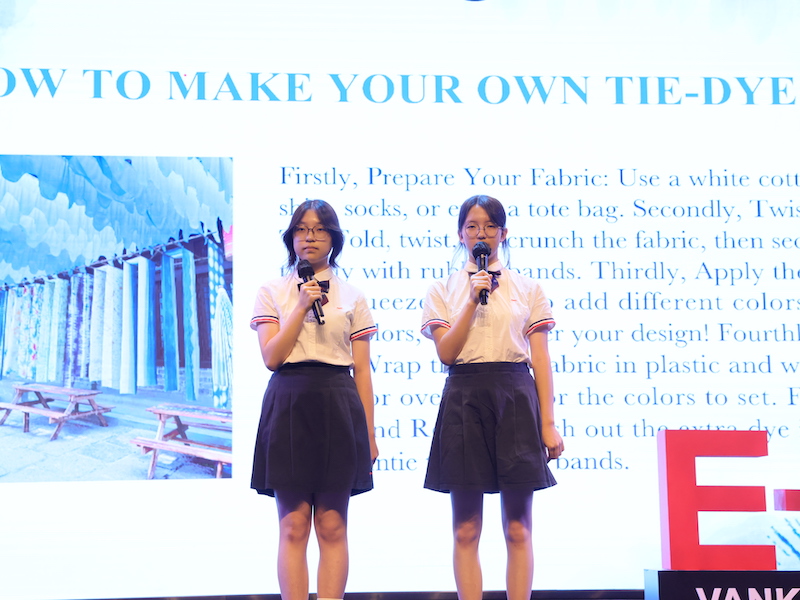
评委Tim老师与Heaven老师对学生的表现给予高度评价:“选手们不仅展现了出色的英语表达能力,更通过多元视角诠释了传统文化的当代生命力。7I班的肖俊博(Thomas)的古琴演奏《流水》,以丝弦之声串联起千年礼乐文明;8E班的濮阳毅(Timmy)与王文昊(Timmy)的《Protect Our Endangered Animal Friends》,从《山海经》祥瑞意象切入,揭示传统文化中‘天人合一’的生态智慧;8D班的邓芃(Thomas)与8C班的廖子汉(Henry)的《The Cultural Symbol of China》,以兵马俑、书法等符号解构中华文明的精神内核。8C班的刘思淇(Alice)与姚罗衾(Ann)的《The Charm of Traditional Skills》,通过剪纸与榫卯工艺的案例,展现非遗技艺的匠心传承;7C班的闫语晨(Emily)与何政东(Ray)的《The Dragon Boat Festival》,从屈原辞赋到龙舟竞渡,还原传统节日的文化肌理;8F班的娄沛思(Pansy)与朱雨昕(Annie)的《Tie-Dye: The Magic of Colors》,以白族扎染的色谱变化,讲述染织工艺里的东方美学。”同时,两位评委建议学生注意演讲语速的节奏把控,加强舞台上的眼神交流与肢体语言张力,让传统文化的叙事更具情感穿透力。
The judges, Teacher Tim and Teacher Heaven, highly praised the students’ performances: “The participants not only demonstrated excellent English expression skills but also interpreted the contemporary vitality of traditional culture from diverse perspectives. Xiao Junbo (Thomas) from Class 7I performed ‘Flowing Water’ on the guqin, connecting the millennia-old etiquette and musical culture through the sound of silk strings; Pu Yangyi (Timmy) and Wang Wenhao (Timmy) from Class 8E presented ‘Chinese Traditional Medicine,’ starting from auspicious images in the ‘Shan Hai Jing’ to reveal the ecological wisdom of ‘harmony between heaven and humanity’ in traditional culture; Deng Peng (Thomas) from Class 8D and Liao Zihan (Henry) from Class 8C, through ‘The Cultural Symbol of China,’ deconstructed the spiritual core of Chinese civilization using symbols like the Terracotta Warriors and calligraphy. Liu Siqi (Alice) and Yao Luoqin (Ann) from Class 8C showcased the meticulous inheritance of intangible cultural heritage through examples of paper cutting and mortise-and-tenon joint craftsmanship in ‘The Charm of Traditional Skills’; Yan Yuchen (Emily) and He Zhengdong (Ray) from Class 7C recreated the cultural fabric of traditional festivals in ‘The Dragon Boat Festival,’ from Qu Yuan’s poem to dragon boat racing; and Lou Peisi (Pansy) and Zhu Yuxin (Annie) from Class 8F illustrated the Eastern aesthetics in dyeing craftsmanship with the color spectrum changes of Bai ethnic tie-dyeing in ‘Tie-Dye: The Magic of Colors.’ ” At the same time, the judges suggested that students pay attention to controlling the rhythm of their speech, strengthen eye contact and body language on stage, and enhance the emotional impact of the narrative on traditional culture.
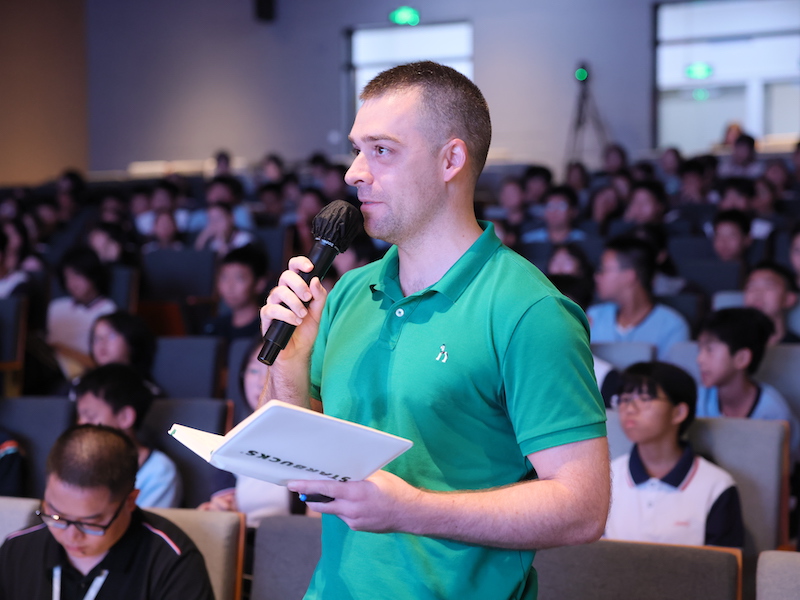
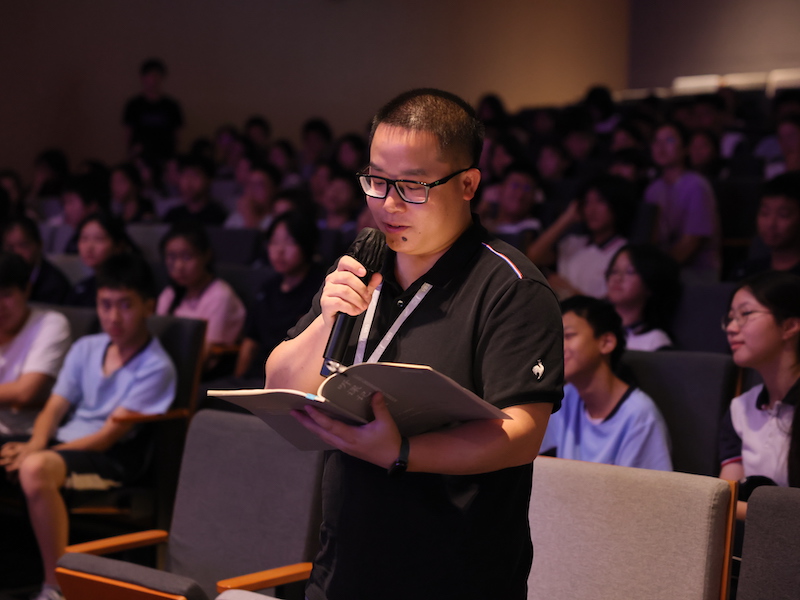
活动尾声,林红英校长助理与评委 Tim、Heaven 为全体演讲者颁发传统文化传承证书,并合影记录这一时刻。
At the conclusion of the event, Principal Lin and judges Tim and Heaven awarded certificates of cultural inheritance to all the speakers and took a group photo to commemorate this moment.
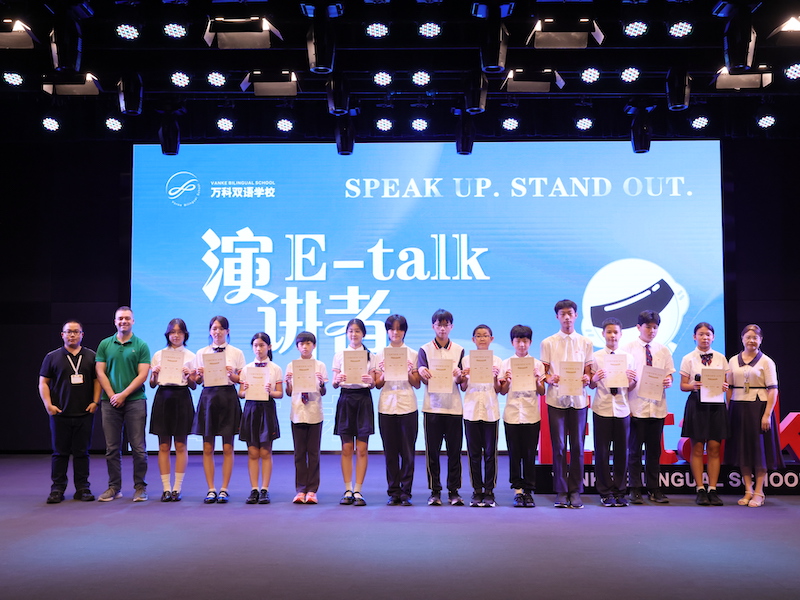
本次“古韵新声” E-talk 活动不仅为学子搭建了展现传统文化素养的舞台,更在校园中播撒了传承文明、守护匠心的种子,激励更多青年成为非遗技艺的践行者与文化薪火的倡导者。正如本次E-talk活动所传递的核心理念:“当年轻一代以匠心与热忱拥抱传统,让剪纸的纹样、陶艺的肌理、书法的笔韵融入时代血脉,人与文明的千年对话便有了最鲜活而坚韧的注脚。”
The “Ancient Charm, Modern Voices” E-talk event not only provided a platform for students to showcase their understanding of traditional culture but also sowed the seeds of civilized heritage and preserving craftsmanship within the campus, inspiring more young people to become practitioners of intangible cultural heritage techniques and advocates for cultural continuity. As conveyed by the core message of this E-talk event: “When the younger generation embraces tradition with skill and enthusiasm, integrating the patterns of paper cutting, the textures of pottery, and the brush strokes of calligraphy into the veins of contemporary society, the millennia-long dialogue between humanity and civilization finds its most vibrant and resilient form of expression.”
万科双语学校E-talk活动每周举行一次,学生自主报名参与,中文、英文均可,老师将相同或相似主题的演讲者安排在同一期演讲,主旨是让学生做到能说、会说、敢说,善思、善辩、善究。
The E-talk activity of Vanke Bilingual School is held once a week. Students can sign up to participate on their own. Both Chinese and English are accepted. The teacher arranges speakers with the same or similar topics to give speeches in the same period. The purpose is to enable students to be able to speak freely, confidently and bravely; to be good at thinking, debating, and doing research.
E-talk的舞台是开放的,我们欢迎每一位VBS未来少年来到这里,站在聚光灯下,向世界展示自己的独特魅力;我们鼓励孩子们挑战自我,突破困境;我们相信,每一个孩子都有无限的潜力,只要他们有勇气站上舞台,就有可能成为真正的演讲者。
The stage of E-talk is open. We welcome every future teenager of VBS to come here, stand in the spotlight, and show their unique charm to the world; we encourage children to challenge themselves and break through difficulties; we believe that every child has unlimited potential. As long as they have the courage to stand on the stage, they may become real speakers.
让我们一起期待,在E-talk的舞台上,VBS未来少年们将如何用他们的声音,引领我们走进他们的世界,感受他们的热情与活力。
Let us look forward to how the future teenagers of VBS will use their voices to lead us into their world and feel their enthusiasm and vitality on the E-talk stage.
附现场视频:
资料提供/ 张紫恒
翻译/ 唐华琳
视频/ 朱敏
排版/ 马葳

万双网讯 为提升学生英语演讲与跨文化表达能力,深化人与动物和谐共处的理念,培养学生面向未来的责任感,2025年6月11日中午13:40,万科双语学校第49期E-talk活动以“古韵新声(Humans and culture)”为主题在学校剧场举行。
To enhance students’ English speaking and cross-cultural expression abilities, deepen the ideals of a harmonious coexistence between humans and animals, and cultivate a sense of responsibility for the future, the 49th E-Talk event at Vanke Bilingual School was held in the school theater on June 11, 2025, at 1:40 PM, with the theme “Ancient Charm, Modern Voice (Humans and Culture).”
活动由7E班的杨静怡(Katerina)和7G班的张蕴哲(Andy)担任主持人,Tim老师和Heaven老师担任评委。来自七、八年级的11名学生用英语分享了他们与传统文化之间的故事与思考,活动吸引了百余名师生到场聆听,并通过校园直播面向全校同步呈现。
The event was hosted by Yang Jingyi (Katerina) from Class 7E and Zhang Yunzhe (Andy) from Class 7G, with Tim and Heaven serving as judges. Eleven students from the seventh and eighth grades shared their stories and reflections on traditional culture in English. The event attracted over a hundred teachers and students to attend and was also broadcast live to all teachers and students.
7I肖俊博(Thomas):Gu Qin
Class 7I Xiao Junbo (Thomas): Gu Qin

7I班的肖俊博在演讲中指出,古琴作为2003年被列入联合国教科文组织非物质文化遗产的“圣人之器”,既是孔子修身养性的工具,承载着儒家文化精神,也是“知音”典故的象征;1977年其曲目《流水》飞向太空,成为人类文化的“宇宙名片”。但如今面临熟练演奏者稀缺、认知偏见及古老记谱法难以传承等困境;为此,他提出通过抖音融合流行元素实现潮流化传播,以及走进博物馆观察木料、感受历史厚重感的保护倡议 。
In his speech, Xiao Junbo from Class 7I pointed out that the Gu Qin, recognized as a “sacred instrument” by UNESCO in 2003 as part of the intangible cultural heritage, is not only an instrument used by Confucius, embodying the spirit of Confucian culture, but also symbolized the tale of “zhiyin” (a close friend who understands you). In 1977, its piece “Flowing Water” was sent into space, becoming a “cosmic business card” of human culture. However, it currently faces challenges such as the scarcity of skilled performers, cognitive biases, and difficulties in passing down ancient notation methods. To address this, he proposed a protection initiative that includes using TikTok to integrate popular elements into trendy videos and visiting museums to observe wood materials and experience the richness of its history.
8E濮阳毅(Hubert)&王文昊(Timmy):Traditional Chinese Medicine
Class 8E Pu Yangyi (Hubert) & Wang Wenhao (Timmy): Traditional Chinese Medicine

8E班的王文昊和濮阳毅在演讲中阐述了中医文化的核心理念——“顺应自然”和“阴阳平衡”。他们提到张仲景提出的四季养生法则及黑芝麻滋阴的现代科学验证。同时,他们列举了针灸、草药、眼保健操等实践案例,既追溯到青铜针治伤的古代应用,又关联到NASA的研究和宇航员带草药上天的现代探索。他们还以屠呦呦发现青蒿素为例,彰显了中医对现代医学的贡献。最后,他们给出饮用柠檬温水等日常养生建议。演讲通过古今案例结合、科学数据佐证,将中医智慧与现代生活紧密相连,兼具文化深度与实用价值。
In their speech, Wang Wenhao and Pu Yangyi from Class 8E elaborated on the core concepts of Traditional Chinese Medicine (TCM) culture— “Harmonizing with Nature” and “Yin-Yang Balance.” They mentioned Zhang Zhongjing’s principles of seasonal health maintenance and the modern scientific validation of black sesame for nourishing Yin. They also cited practical examples such as acupuncture, herbal medicine, and eye exercises, tracing back to ancient uses of bronze needles for healing, while connecting these to NASA’s research and usage of herbal medicine by astronauts in space. They highlighted the contributions of TCM to modern medicine by referencing Tu Youyou’s discovery of artemisinin. Finally, they provided daily health tips such as drinking warm lemon water. Their speech effectively intertwined ancient and modern examples with scientific data, connecting the wisdom of TCM with contemporary life, showcasing both its cultural depth and practical value.

8D邓芃(Thomas)&8C廖子汉(Henry):The Cultural Symbol of China
Class 8D Deng Peng (Thomas) & Class 8C Liao Zihan (Henry): The Cultural Symbol of China

8C班的邓芃和8D班的廖子汉在演讲中聚焦中国文化符号——剪纸与灯笼。他们介绍,剪纸自汉代起源,唐宋盛行,历经1500多年,凭借剪刀、彩纸等简单工具,以红色为基调创作图案,在春节、婚礼等场景传递吉祥寓意。灯笼则始于西汉,从实用照明逐渐演变为唐代元宵节的象征。红灯笼寓意团圆兴旺,天灯承载美好愿景。作为活态文化遗产,红灯笼和天灯凝聚着人们对生活的热爱与期盼。他们呼吁年轻人积极传承这些艺术形式,让它们承载的希望与梦想永葆生机。
In their speech, Deng Peng from Class 8C and Liao Zihan from Class 8D focused on some cultural symbols of China—paper cutting and lanterns. They introduced the history of paper cutting, which originated in the Han Dynasty and became popular during the Tang and Song Dynasties. Over 1,500 years, it has been made from simple tools like scissors and colored paper to create patterns with a red theme, conveying auspicious meanings during occasions such as the Spring Festival and weddings. Lanterns, which began in the Western Han Dynasty, evolved from a practical lighting method to a symbol of the Lantern Festival in the Tang Dynasty. Red lanterns symbolize reunion and prosperity, while sky lanterns carry beautiful wishes. As a living cultural heritage, red lanterns and sky lanterns embody people’s love and hopes for life. They called on young people to actively practice these art forms, ensuring that the hopes and dreams they represent continue to thrive.

8C刘思淇(Alice)&姚罗衾(Ann):The Charm of Traditional Skills
Class 8C Liu Siqi (Alice) & Yao Luoqin (Ann): The Charm of Traditional Skills

8C班的刘思淇和姚罗衾在演讲中深入展现了传统技艺糖画与刺绣之美。糖画源于明代祭祀,清代演变为街头艺术。艺人以勺作笔、糖液为墨,在光滑板上即兴勾勒龙、花等图案,几秒即成。她们还结合班级同学父亲在学校神话节设摊的实例,体现了糖画的受欢迎程度,并赞叹了古人的智慧。刺绣则自周代起源,从宫廷装饰发展成了中国美学巅峰代表。它经过印图、针法绣制、装裱等繁复流程,一件精品往往耗时数月。她们致敬姚建平、顾文霞等传承人,盛赞其用针线赋予丝绸生命力,凸显传统技艺传承的不易与珍贵。
In their speech, Liu Siqi and Yao Luoqin from Class 8C showcased the beauty of traditional crafts, specifically sugar painting and embroidery. Sugar painting originated from sacrificial rituals in the Ming Dynasty and evolved into a form of street art during the Qing Dynasty. Artists use a spoon as a pen and sugar syrup as ink to spontaneously sketch patterns such as dragons and flowers on a smooth surface, completing works in just a few seconds. They also referenced an example of a classmate’s father setting up a stall at the school’s Mythology Festival, highlighting the popularity of sugar painting and marveling at the wisdom of ancient artists. Embroidery, which began in the Zhou Dynasty, developed from court decorations to become a pinnacle of Chinese aesthetics. It involves complex processes such as pattern printing, stitching techniques, and framing, and a fine piece can take months to create. They paid tribute to practitioners like Yao Jianping and Gu Wenxia, praising their ability to breathe life into silk with their needles and thread, highlighting the challenges and value of preserving traditional crafts.

7C闫语晨(Emily)&何政东(Ray):The Dragon Boat Festival
Class 7C Yan Yuchen (Emily) & He Zhengdong (Ray): The Dragon Boat Festival

7C班的闫语晨与何政东以“端午节:传统节日的文化密码”为题展开演讲。他们先介绍了端午节在农历五月初五,又称“重五节”,是为纪念屈原而设立的节日,并于2009年成为首个列入联合国教科文组织非物质文化遗产的中国节日。接着,他们阐述了端午节习俗背后的深层内涵:挂艾草、饮雄黄酒是雨季天然的防虫保健方式,体现人与自然和谐相处的理念;赛龙舟需众人依鼓点协作,彰显团结精神;全家包粽子则承载着浓厚的家庭温情。最后,他们提出青年传承的建议,鼓励同学们在校参与文化项目、创办社团,与家人共度节日并通过社交媒体传播。他们强调,端午节作为文化核心,是连接古今的桥梁,呼吁大家共同守护传承这一节日的独特魅力。
Yan Yuchen and He Zhengdong from Class 7C delivered a speech titled “The Dragon Boat Festival: The Cultural Code of Traditional Festivals.” They began by introducing the Dragon Boat Festival, celebrated on the fifth day of the fifth lunar month, also known as “Double Fifth Festival,” which was established to commemorate Qu Yuan and was recognized as the first Chinese festival included in UNESCO’s Intangible Cultural Heritage list in 2009. Next, they elaborated on the deeper meanings behind the customs of the Dragon Boat Festival: hanging mugwort and drinking realgar wine are natural ways to deter insects during the rainy season, reflecting the idea of harmonious coexistence between humans and nature; dragon boat racing requires teamwork in sync with the drum beats, showcasing the spirit of unity; and making zongzi (sticky rice dumplings) as a family carries deep familial warmth. Finally, they proposed suggestions for youth activities, encouraging classmates to participate in cultural projects, establish clubs, celebrate the festival with their families, and share their experiences on social media. They emphasized that the Dragon Boat Festival, as a cultural core, serves as a bridge connecting the ancient and the modern, calling on everyone to jointly preserve the unique charm of this festival.

8F娄沛思(Pansy)&朱雨昕(Annie):Tie-Dye: The Magic of Colors
Class 8F Lou Peisi (Pansy) & Zhu Yuxin (Annie): Tie-Dye: The Magic of Colors

8F班的娄沛思和朱雨昕在演讲中介绍了扎染。那是一种通过捆绑折叠布料染色的古老工艺,起源于中、印、非洲古代。20世纪60年代,沾染在美国被认为是和平、自由象征。扎染没有规则限制,能够激发创意,使用的材料简单有趣,还可以用于改造旧衣物,兼具环保与时尚的特点。扎染的制作步骤包括准备布料、造型、染色、静置和冲洗。扎染的应用非常广泛,许多知名品牌都采用了这种工艺。作为一种手工艺,它传承着古老的民族文化。在演讲中,娄沛思和朱雨昕以清晰的脉络结合了扎染的历史渊源、操作实践和现代价值,并通过“失误变设计”等细节增强了演讲的吸引力。
In their speech, Lou Peisi and Zhu Yuxin from Class 8F introduced tie-dyeing, an ancient craft of coloring fabric through binding and folding, which originated in China, India, and Africa. In the 1960s, tie-dye became a symbol of peace and freedom in the United States. Tie-dyeing has no strict rules, allowing for creativity to flourish, and the materials used are simple and fun. It can also be employed to transform old clothing, embodying both environmental friendliness and style. The steps in creating tie-dye include preparing the fabric, shaping it, dyeing, letting it sit, and rinsing with water. The application of tie-dye is very widespread, and many well-known brands have adopted this technique. As a form of craftsmanship, tie-dye carries the heritage of ancient ethnic culture. In their speech, Lou Peisi and Zhu Yuxin clearly connected its historical origins, practical operations, and modern value, enhancing the appeal of their presentation with phrases such as “turning mistakes into designs.”

评委Tim老师与Heaven老师对学生的表现给予高度评价:“选手们不仅展现了出色的英语表达能力,更通过多元视角诠释了传统文化的当代生命力。7I班的肖俊博(Thomas)的古琴演奏《流水》,以丝弦之声串联起千年礼乐文明;8E班的濮阳毅(Timmy)与王文昊(Timmy)的《Protect Our Endangered Animal Friends》,从《山海经》祥瑞意象切入,揭示传统文化中‘天人合一’的生态智慧;8D班的邓芃(Thomas)与8C班的廖子汉(Henry)的《The Cultural Symbol of China》,以兵马俑、书法等符号解构中华文明的精神内核。8C班的刘思淇(Alice)与姚罗衾(Ann)的《The Charm of Traditional Skills》,通过剪纸与榫卯工艺的案例,展现非遗技艺的匠心传承;7C班的闫语晨(Emily)与何政东(Ray)的《The Dragon Boat Festival》,从屈原辞赋到龙舟竞渡,还原传统节日的文化肌理;8F班的娄沛思(Pansy)与朱雨昕(Annie)的《Tie-Dye: The Magic of Colors》,以白族扎染的色谱变化,讲述染织工艺里的东方美学。”同时,两位评委建议学生注意演讲语速的节奏把控,加强舞台上的眼神交流与肢体语言张力,让传统文化的叙事更具情感穿透力。
The judges, Teacher Tim and Teacher Heaven, highly praised the students’ performances: “The participants not only demonstrated excellent English expression skills but also interpreted the contemporary vitality of traditional culture from diverse perspectives. Xiao Junbo (Thomas) from Class 7I performed ‘Flowing Water’ on the guqin, connecting the millennia-old etiquette and musical culture through the sound of silk strings; Pu Yangyi (Timmy) and Wang Wenhao (Timmy) from Class 8E presented ‘Chinese Traditional Medicine,’ starting from auspicious images in the ‘Shan Hai Jing’ to reveal the ecological wisdom of ‘harmony between heaven and humanity’ in traditional culture; Deng Peng (Thomas) from Class 8D and Liao Zihan (Henry) from Class 8C, through ‘The Cultural Symbol of China,’ deconstructed the spiritual core of Chinese civilization using symbols like the Terracotta Warriors and calligraphy. Liu Siqi (Alice) and Yao Luoqin (Ann) from Class 8C showcased the meticulous inheritance of intangible cultural heritage through examples of paper cutting and mortise-and-tenon joint craftsmanship in ‘The Charm of Traditional Skills’; Yan Yuchen (Emily) and He Zhengdong (Ray) from Class 7C recreated the cultural fabric of traditional festivals in ‘The Dragon Boat Festival,’ from Qu Yuan’s poem to dragon boat racing; and Lou Peisi (Pansy) and Zhu Yuxin (Annie) from Class 8F illustrated the Eastern aesthetics in dyeing craftsmanship with the color spectrum changes of Bai ethnic tie-dyeing in ‘Tie-Dye: The Magic of Colors.’ ” At the same time, the judges suggested that students pay attention to controlling the rhythm of their speech, strengthen eye contact and body language on stage, and enhance the emotional impact of the narrative on traditional culture.


活动尾声,林红英校长助理与评委 Tim、Heaven 为全体演讲者颁发传统文化传承证书,并合影记录这一时刻。
At the conclusion of the event, Principal Lin and judges Tim and Heaven awarded certificates of cultural inheritance to all the speakers and took a group photo to commemorate this moment.

本次“古韵新声” E-talk 活动不仅为学子搭建了展现传统文化素养的舞台,更在校园中播撒了传承文明、守护匠心的种子,激励更多青年成为非遗技艺的践行者与文化薪火的倡导者。正如本次E-talk活动所传递的核心理念:“当年轻一代以匠心与热忱拥抱传统,让剪纸的纹样、陶艺的肌理、书法的笔韵融入时代血脉,人与文明的千年对话便有了最鲜活而坚韧的注脚。”
The “Ancient Charm, Modern Voices” E-talk event not only provided a platform for students to showcase their understanding of traditional culture but also sowed the seeds of civilized heritage and preserving craftsmanship within the campus, inspiring more young people to become practitioners of intangible cultural heritage techniques and advocates for cultural continuity. As conveyed by the core message of this E-talk event: “When the younger generation embraces tradition with skill and enthusiasm, integrating the patterns of paper cutting, the textures of pottery, and the brush strokes of calligraphy into the veins of contemporary society, the millennia-long dialogue between humanity and civilization finds its most vibrant and resilient form of expression.”
万科双语学校E-talk活动每周举行一次,学生自主报名参与,中文、英文均可,老师将相同或相似主题的演讲者安排在同一期演讲,主旨是让学生做到能说、会说、敢说,善思、善辩、善究。
The E-talk activity of Vanke Bilingual School is held once a week. Students can sign up to participate on their own. Both Chinese and English are accepted. The teacher arranges speakers with the same or similar topics to give speeches in the same period. The purpose is to enable students to be able to speak freely, confidently and bravely; to be good at thinking, debating, and doing research.
E-talk的舞台是开放的,我们欢迎每一位VBS未来少年来到这里,站在聚光灯下,向世界展示自己的独特魅力;我们鼓励孩子们挑战自我,突破困境;我们相信,每一个孩子都有无限的潜力,只要他们有勇气站上舞台,就有可能成为真正的演讲者。
The stage of E-talk is open. We welcome every future teenager of VBS to come here, stand in the spotlight, and show their unique charm to the world; we encourage children to challenge themselves and break through difficulties; we believe that every child has unlimited potential. As long as they have the courage to stand on the stage, they may become real speakers.
让我们一起期待,在E-talk的舞台上,VBS未来少年们将如何用他们的声音,引领我们走进他们的世界,感受他们的热情与活力。
Let us look forward to how the future teenagers of VBS will use their voices to lead us into their world and feel their enthusiasm and vitality on the E-talk stage.
附现场视频:
资料提供/ 张紫恒
翻译/ 唐华琳
视频/ 朱敏
排版/ 马葳
办学理念:让孩子站在未来中央
培养(成长)目标:培养(成为)身体健康、人格健全、学力卓越,具有家国情怀和国际视野, 敢于创造美好未来的中国公民。
地址:深圳市龙华区民治街道华南路80号
电话:0755-66866333
http://vbs.vanke.com
Vanke Bilingual School, Longhua District, Shenzhen
Educational Idea: Let our children experience the future.
Training objectives: our students will become citizen of China with good physical health, sound personality, excellent academic abilities, patriotism, international vision and the courage to create a better future.
Address: No.80 Huanan Road, Minzhi Sub-district, Longhua District, Shenzhen
Contact: 0755-66866333
http://vbs.vanke.com

学校网站二维码
QR code of school website
学校公众号二维码
QR code of school official account